Now We Are Running Frantically Away from the Sun
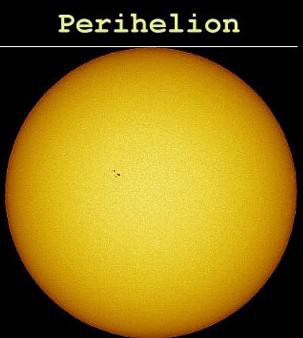
You know how thinking about space and the speed of celestial bodies makes you kind of want to vomit and put your hands over your ears and lay flat on the ground, like a car-sick dog? Well, bad news! Because yesterday we were pretty much as close to the sun as we ever get, and now we are rocketing away from it and, if I understand the math, picking up speed as we travel away. The good news is that the sun looks about 3% bigger than it does in mid-summer! And there’s more light, so your SAD is easily treatable. And if you’d like to learn more and/or argue about celestial math, elliptical orbits and acceleration, here is the place to do so.
PandaCow: The Cow That Looks Like A Panda
It’s a cow! It’s a panda! It’s the result of a genetic manipulation that is a testament to all the super-important uses we are putting Science to these days! It’s PandaCow! Man, it’s going to be another great year for wacky animal stories, I just know it.
Come On Darkness

Our pingy-pongy weather (how ‘bout that snowstorm, huh?) takes one final bounce today before settling in for a run of seasonal chill and grimness. (AccuWeather is forecasting “times of sun and clouds” for next week, which sounds like some kind of work of magical realism as written by Sam Champion.) Plus there may be more snow on the way! In any event, today looks to be the last time we see 40 degree temperatures for some time, so, in the spirit of goodwill and renewal, for today only, I am giving you all permission to wear shorts. Don’t waste it!
Photo by caks, from Flickr.
"The Future Is Now": Download Amy Jean Porter's 2011 Desktop Calendar!
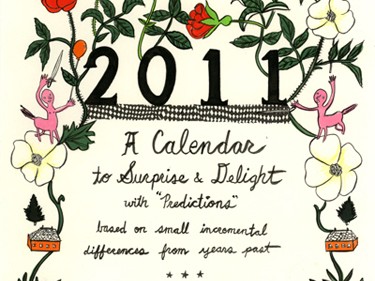
Ladies and gents, it’s the “Drawings in a Hurry: The Future is Now, 2011” calendar! Amy Jean Porter has made a drawing for each month, each of which tiles delightfully on your computer monitor. You can download the calendar, without captions, most easily here, in an adorable little zip file. [2.8MB] Those are the most handsome. Or you can download the calendar with captions here, if you like words, and who doesn’t? [3.4MB] Would you like to see it in action on my desktop?
Here’s the version with captions.
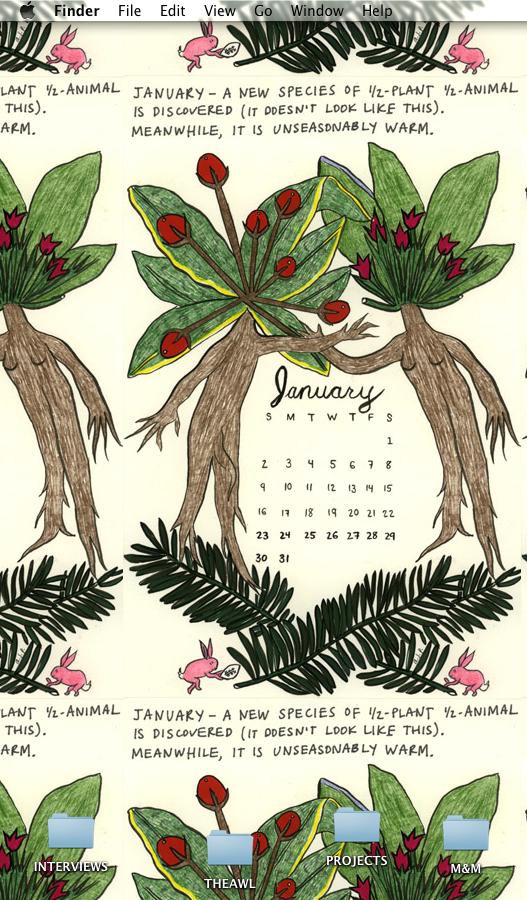
And here’s the textless version, which does indeed tile most handsomely!
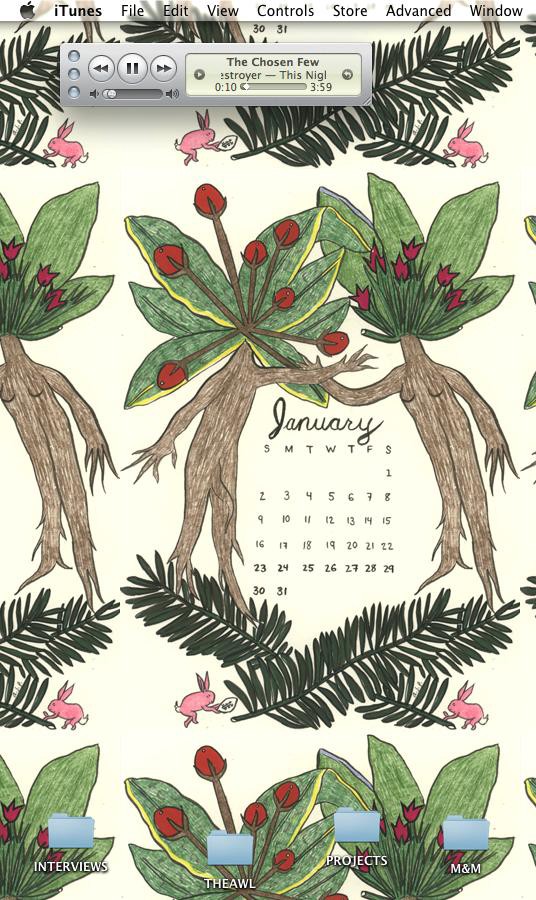
Of course you can always choose to display it centered on a background or what have you. It’s your computer! Go nuts!
And yes, this is low-tech high-tech. You’ll have to remember to change over each month yourself. Here’s a look at each month.
For the computerphobic Mac user, just:
1. Download the file.
2. Unstuff it!
3. Open System Preferences/Desktop and Screensaver.
4. On the bottom left, hit the “plus” symbol to add a folder.
5. Add the unstuffed calendar’s folder, which will most likely be in your Downloads folder.
6. Pick the month and choose “tile.” Changing the month is easy — that folder will always be available now.
I’m sure you PC users can figure it out easily enough — or can eHow it.
Amy Jean Porter recently produce a print with 20×200. She also recently finished 106 drawings for her first book, “Of Lamb,” a collaboration with poet Matthea Harvey, to be published in early 2011.
All Of The End Of The World

Thanks to everyone who participated in our end of the world exercise. Perhaps you missed one of two during the hectic holiday week. Good news: they’re all here! Print and save for later… or for the actual end of the world. You’ll have plenty of time for reading then.
• Actions Have Consequences, or, I’ll See You in Hell, by Miles Klee
• At the End of the World with Gauntlet Hair, by Matthew Perpetua
• Galactic Zero, by Rachel Herman-Gross
• Going To Zero, by Kevin Depew
• Mannahatta, Mon Amour, by Matthew Gallaway
• Massachusetts 2011: The Abstract State, by Jessanne Collins
• Not Calling Next Year ‘Twenty Eleven’ Will Be the End of Us All, by Jack Stuef
• Our Brief Fossil Record, by Hillary Frey
• Possible Resolutions For The Apocalypse Year, by Natasha Vargas-Cooper
• Social Networking Alternatives For After the Apocalypse, by Alex Blagg
• Stand-Up in the Post-Apocalyptic Wasteland: Journal Excerpts of the Omega Comedian, by Josh Luft
• The Blackboard, Slated to be Wiped Clean, by Mark Lotto
• The Girl in the Dress: Taylor Swift’s Endless Reign, by Daniel D’Addario
• The IRS Should Be Your Last Worry. We Can Help., by Abe Sauer
• The Late Great Planet Earth, by Robert Lanham
• The Laws of a Year of Blessed Silence, by Richard Rushfield
• The Next New World, by Maria Bustillos
• The Road To Hell Is Paved With Compostable Bags, by Cord Jefferson
• The Shake Of Things To Come, by Susie Cagle
• The Tumblr at the End of the World, by Sady Doyle
• The Ultimate Year, by Brent Cox
• To the Class of 2011, by Mike Barthel
• Wait For It, by Mike Riggs
• Welcome to the Hipocalypse, by Erica Sackin
• What We Mean When We Say “The End Of The World”, by Bethlehem Shoals
• You Won’t Be the Same Person When You Wake Up Next Year, by Sunny Biswas
Photo by Nathan Siemers, from Flickr.
My New Year's Resolutions In Order Of How Likely They Are To Be Kept
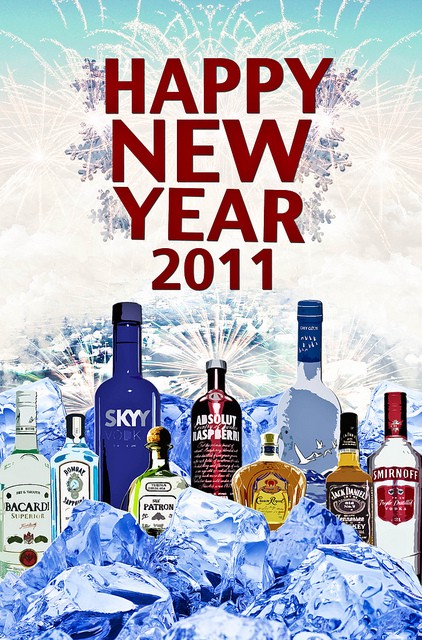
Drink more efficiently.
Smoke a pack of cigarettes maximum each day. Okay, maybe a pack and a half on really stressy days.
Read at least one actual book a month, with the computer and other distractions shut down.
Give blood more often.
Try not to respond to information sent my way with the dismissive rejoinder, “Yeah, I remember last week.”
Remind the people I love that I love them.
Disregard the continuing and inexplicable existence of people who bother me.
Lose so much weight that I disappear completely.
Weep less.
Hold every moment in the palm of my hand and realize that life is finite and there are only so many events one is lucky enough to experience during the brief time allotted on this earth, so it’s better to appreciate each one for what it is rather than to be cynical or bitter or, worst of all, bored by it; realize that there is something precious about everything no matter how mundane it seems as it happens.
See the doctor.
Happy New Year, Ross Douthat, Let's Talk About Abortion
“Since 1973, countless lives that might have been welcomed into families like Thernstrom’s — which looked into adoption, and gave it up as hopeless — have been cut short in utero instead. And lives are what they are. On the MTV special, the people around Durham swaddle abortion in euphemism. The being inside her is just ‘pregnancy tissue.’ After the abortion, she recalls being warned not to humanize it: ‘If you think of it like [a person], you’re going to make yourself depressed.’ Instead, ‘think of it as what it is: nothing but a little ball of cells.’ It’s left to Durham herself to cut through the evasion. Sitting with her boyfriend afterward, she begins to cry when he calls the embryo a ‘thing.’ Gesturing to their infant daughter, she says, ‘A ‘thing’ can turn out like that. That’s what I remember … ‘Nothing but a bunch of cells’ can be her.’ When we want to know this, we know this.”
— The arguer in me wants me to seize upon the word “want” in that last sentence, and tell Ross Douthat, Sure, yes, when we want to believe something, so as to make the world line up with our personal religious inclination, we can make ourselves — we can blur the line between personal experience and logic, and, semantically, between “believing” and “knowing,” too. But that is a type of cheating. And it doesn’t change the fact that abortion should be kept legal and available to any pregnant woman who so chooses. But the reader in me is thankful for a compelling challenge to my own views.
The 10 Most Wonderful Internet Films of 2010
by Eric Spiegelman
Here are ten videos, culled from the neverending stream of Internet things that pass by my face each day, ten videos that will make you feel good about the world. They’re all from this year, a year that I can say confidently had way more suck than it had awesome; but if you take half an hour to ignore all the suck and watch these you will come away thinking, man, people still make some beautiful things, even in the midst of shit raining down, even if only they’re tiny little Internet videos. This was a running list I started in January, a list I only added to when moved to do so. And there was not much paring down that happened when I looked back at the collection this week, which proves I have very high standards — because let me tell you I saw a LOT of cute animal videos this year, and only two made this list. Looking at them all again, it’s clear that I responded to things that were delightful, clever and sometimes poignant.
1) These are in no particular order, but above is clearly the most wonderful video of 2010: “Words,” by Will Hoffman and Daniel Mercadante, produced for WNYC’s Radiolab program to accompany one of its episodes. It probably takes about a minute for you to go, “Oh, I see what they’re doing here,” and then you’ll go back and watch the whole thing again because now you get it. And for anyone who got out a relationship this year, there’s one shot that might just kill you.
2) The music video for “Red Lights” by the band Holy Fuck elevates the genre of Cats Doing People Things to a level not seen since the 1970s. Indeed, this could be the Internet generation’s The Aristocats or The Cat From Outer Space. Re-imagining the most famous scene in Bullitt as a dog chasing a cat is a “how did nobody think of this yet” kind of genius, but it comes with a danger. When dealing with the obvious yet undiscovered, the bar is automatically set really high, because the audience “gets it” before they even see it and thus demands an execution on par with their expectations. The filmmakers here, Brian Borcherdt and Michael LeBlanc, they do not disappoint.
3) A couple filmmakers out of Weehawken, New Jersey wanted to get the attention of HBO, so they made a promo spot for “Boxing After Dark,” totally on spec. HBO, turns out, didn’t give a damn. But a lot of other people did, and Liam O’Neil and Jason Koburov found themselves pursued by a number of top talent management firms in Hollywood, who thought they should be in the feature film business instead of the making commercials for free business. It’s easy to see why, since their video, “I Still Have A Soul,” tells a compelling story in just two minutes.
HBO “I Still Have A Soul” from Paradise Square Films on Vimeo.
4) This year’s British elections didn’t quite rouse the spontaneous mass creative impulse that characterized the Obama campaign of 2008, but this video made by “nathankw,” a fan of the Lib Dems, wins out over that sappy Will.I.Am video any day.
5) Creating things for the love of creating things basically defines the Goddamn Cobras Collective, a group of Brooklyn twenty-somethings with day jobs who all get together in their off hours to produce stuff. They have a whole series of local bands doing live covers of popular songs while a bunch of friends sit around and enjoy the performance. This one, “Wakey! Wakey! part 2,” is perhaps the most endearing. It’s a cover of “Ambling Amp” by Yeasayer, all warm and beautifully shot and, damn, I wish I got invited to parties like these. Replacing the synthesizer with a violin was a great idea.
Cobra Den Invitational: Wakey!Wakey! — Ambling Alp (Yeasayer) from Goddamn Cobras Collective on Vimeo.
6) Hey, remember the Olympics this year? Probably not. (It was a Winter Olympics. Hmm.) But some people really cared about them. Like this group of musicians dressed in the traditional clothing of ethnic Tatars, playing authentic Tatar instruments, and singing a cover of “We Are The Champions.” In one of the Tatar dialects.
7) Just about everyone on the Internet saw this one, I’m sure, but Patrick Jean’s “Pixels” can be watched again and again without any loss of delight. Classic 8-bit arcade games invade Manhattan. Fantastically clever.
8) “Oops” won this year’s Vimeo award for best experimental video. Chris Beckman took a bunch of footage of people dropping their cameras while shooting with them, then he edited it all together quite seamlessly. Is it a commentary on our perpetually imperfect relationship with technology? Eh, probably not. But it’s damn compelling and more than a little hypnotic.
oops from Chris Beckman on Vimeo.
9) Ok Go could probably have three videos on this list. They “get” the Internet. But I’m going with “White Knuckles,” directed by Trish Sie, as the best of the bunch, because it features the choreography of trained dogs.
10) My sardonic cousin refers to An Inconvenient Truth as the most successful powerpoint deck ever created. That’s the issue with environmentalist message movies, they’re often pretty boring. Or, as in the case of The Day After Tomorrow, just plain stupid. But neither can be said about Ramin Bahrani’s “Plastic Bag,” which follows the journey of a pollutant through the pollutant’s own perspective, humanizing it, making you sympathize with it, until you feel sad for its very existence — not for the sake of the Earth, mind you, but for the sake of the pollutant itself. It’s a new twist on the old message of vampire books and ancient mythology. Being immortal — or, in this case, non-biodegradable — really kind of sucks.
BONUS! Of course you finish up your best of the year list and then something pops up at the last minute and warrants inclusion. So here’s number eleven on my top ten list. “Dueling Cameras” by Adam Lisagor and Noah Kalina, skating in at the end of the year. Adam wrote about the video, “halfway through [production], I realized that it’d been the first time in a long while I’d made something just for the hell of it. And I remembered how good that feels.” That seems like a pretty good place to end. And also a sentiment that sums up the spirit behind everything on this list. Happy New Year, everyone!
Dueling Cameras from lonelysandwich on Vimeo.
Eric Spiegelman is a proprietor of Old Jews Telling Jokes.
The Blackboard, Slated to be Wiped Clean
by Mark Lotto
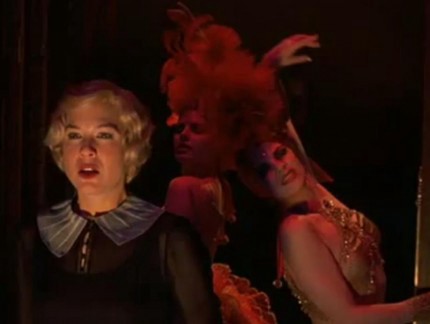
The day I learned that the Earth would be cracked open by a comet, that the seas would turn suddenly to steam and the wind from every direction would catch fire, that the sky would be covered over with heavy tarps of black burning dust and every one of us would end up stenciled like letters into the fossil record, I went to the movies. But then Richard Gere burst out into “Razzle Dazzle,” and my heart went nuts and my head went light and my skin went damp and it went cold and the only thought I could manage was this: “The world is going to end and I’m sitting here watching fucking Chicago.”
This was 2003, and on NASA’s “Upcoming Close Approaches to Earth” table, there were no disconcertingly near near-earth objects.
On the Torino Impact Scale, there weren’t any 8’s (“A collision is certain, capable of causing localized destruction”), 9’s (“A collision is certain, capable of causing unprecedented regional devastation”) or 10’s (“A collision is certain, capable of causing global climatic catastrophe that may threaten the future of civilization as we know it,”) — not even a 2 (“a discovery, which may become routine with expanded searches, of an object making a somewhat close but not highly unusual pass near the Earth”). Out on the streets, no one had pulled over to stare up at a wrong-colored sky. Instead, traffic kept inching along and people kept doctor’s appointments and dinner dates; the grocery store shelves were still well-stocked. Everyone was basically fine, I guess, except me.
Blame Harper’s, and a Tom Bissell piece I’d read that morning, about comet strikes and asteroid impacts and the scientists who study them. His conclusion, after 15 calamitous pages:
Mass extinction serves as speciation’s necessary foil, and the victims run well into the millions: today’s extant species account for less than one per-cent of the total number to have ever lived… Life is a huge blackboard filled with a million marks of chalk. Every thirty million years that chalkboard is forcefully wiped clean, leaving only a few small smudges in the comers, whereupon life begins again without regard to perfection of adaptation, what has come before it, or the miserable consciousnesses of those few creatures able to wonder why they are here.
My blackboard? That fucking thing? I’d filled it with a million pointless marks, itineraries that had led me farther astray, stories I told about myself to myself to make me smaller and sorrier, resume lines designed to punish me then and embarrass me later, rotten relationships and blacked-out nights and the pounds I’d put on. I wanted it all forcefully wiped clean, not thirty million years in the future or thirty, but that day, or the next, and not by some screaming snowball whose meaningless orbit would vaporize everything that had ever meant anything to us — every bad marriage and every good one, every mailbox and most every flower — but by simply, suddenly, spectacularly, choosing better and choosing to be better. I wanted my world to get started before it ended.
I stayed there panicking and palpitating in the giant, dark theater all the way until Velma and Roxie reprised “All That Jazz.” And by the time I stumbled back out into the radioactive L.A. sun, I’d resolved to un-fuck my life. It took a whole lot longer than I expected, and maybe I’m still working on it. Maybe there’ll be time, though, to become a real and proper human being. Before you go the way of the dinosaurs, you want to squeeze in as much evolution as you can.
Mark Lotto is an editor at the New York Times.
Looking Back At 'A Season Inside'
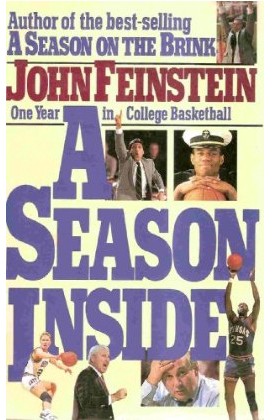
When I was 13, I was a supreme nerd. Having bought in fully to the vision of my college prof parents, I had in my sights nothing less than utter and complete academic domination of Beaumont Junior High School. For a while, I was well on my way. I had taken four of the six end-of-the-year academic awards and I was one of only two students in the school who got a library pass for the half-hour to 45 minutes before the first class bell rang. This is why the septuagenarian librarian was the first person to sign my 7th grade yearbook. This fact is as true as it is sad.
My particular brand of nerddom was aerodynamics. By the 6th grade I had already scouted colleges and determined that Embry-Riddle Aeronautical University — the nation’s pre-eminent destination to study, um, aeronautics — would be my next step after that mere stepping stone that was high school.
But that was down the road. The first tangible step of the plan was to win the school science fair. After researching extensively, in the library of course, the properties of flight — drag coefficient, lift, etc. — I built from an old appliance box a working wind tunnel, complete with dry ice and box window fan. I cut a viewing port in the side of the box and attached an F-14 tomcat model using some of my dad’s fishing wire. And it all worked quite well, actually. So well, in fact, I won the school event, earning a trip to the countywide level. The judges universally applauded my use of items found around the house and the earnestness with which I had put the whole thing together. At the county science fair, I took second, wearing home with pride my red second-place ribbon. This meant a trip to state. Destiny was upon me.
But the onramp to NASA brilliance would prove to be paved with some humility. My homemade wind tunnel wasn’t quite the stuff of science fair legend, apparently, and I walked away from the big dance with a yellow participant ribbon and just enough taste of scientific glory/bitterness to keep me hungry. After seeing the caliber of setup that had been my undoing at the state fair, I was determined next time to not let limited resources be my demise. The next year, eschewing a fresh idea I built a new wind tunnel out of plywood, cut fiberglass, a new and more powerful fan and a fresh out of the box F-16 Fighting Falcon. I was confident it was state champion worthy, and quite possibly my ticket to untold fortunes.
But a funny thing happened. The new, slicker update held none of the quaint elegance the previous year’s model had. My design was better, but the execution came off as over-planned and precious. Instead of bringing me wide acclaim, I was left cramming the bulky, dumb project into the trunk of the car, just another loser among losers of the Beaumont Junior High Science Fair.
Well, suffice it to say my amateur ambition for aeronautic glory ended with a thud. Within two years I had abandoned the dream in toto, as much for Metallica and girl watching as for any failure to achieve science fair mythological status.
Last month I decided to break away from a steady diet of overlarge history books and read a sports book. Despite my obsessive interest in sports, I hadn’t read one since finishing Michael Lewis’ Moneyball probably five years ago. In part because of this column, I selected John Feinstein’s book about Bobby Knight and the Indiana Hoosiers, A Season On the Brink, as my return engagement. But none of the three used bookstores I went to had A Season On the Brink, so I settled for the one one of them did have, his follow-up to that bestseller, A Season Inside.
I’d specifically avoided Feinstein for years due to what I considered his unnecessary personal hatred for the Kentucky program (more on that later). But A Season On the Brink is supposed to be a classic, and the subject matter of the sequel looked fine, so I swallowed my big blue pride and dug in.
Feinstein’s first book follows Knight and his antics through a single season at the peak of his Knight-ness, getting into the personal and professional alike. The book was an unmitigated success, riding the top of New York Times Bestseller List for 17 weeks. It made Feinstein — until then a well-regarded sportswriter for the Washington Post — a star, and spawned a whole genre of embedded reporter sports book. It appears A Season Inside was Feinstein’s attempt at his own plywood and fiberglass wind tunnel, designed to do with the whole 1987–88 season’s worth of characters what he’d done to such glorious acclaim with Bobby Knight a few years before.
But like my fancier wind tunnel, the results fell short. The book got decent enough reviews, but never came close to the sort of fawning praise Brink received, and reading it one walks away with a strong sense of the basketball moment, but also a sense that the scope was perhaps beyond one writer. Some characters do get a fuller treatment, but none get the real depth of coverage that Feinstein was able to get with Knight. This isn’t necessarily the writer’s fault. Sometimes the wind tunnel is just better in cardboard.
In the book, much attention is paid to Danny Manning, whose heroics in that season’s NCAA tournament are now part of the game’s lore. But others who get the most QT from Feinstein are those he deemed to have that season’s most engaging profiles.
Mostly forgotten now, Arizona guard Steve Kerr — later sidekick of Mister Jordan in Chicago — is essentially the book’s frame. Kerr’s personal history of strength through tragedy was compelling that year, but with hindsight he didn’t made much of a mark in college hoops history. It’s pretty clear why a frumpy white sportswriter would find Kerr more approachable. Kerr is white, articulate and quotable. That’s a holy triumvirate for old guard sportswriters.
Beyond those few, there are some great throwaway names, illuminating mostly for who went on to make a name for themselves and who did not. In the background, you hear about the on-court exploits of guys who would have effective pro careers like Will Purdue, Sean Elliott, Jud Buechler, and Mitch Richmond, guys like Charles Shackleford and Jerome Lane who were pro busts, and then the guys only a few of us even recall — your Barry Goheens, Rodney Monroes and Kevin Houstons. But, however unintentional, this sort of frozen moment in time is what actually makes A Season Inside more enjoyable for hoops nerds like me than its execution as a book. This was a more innocent time for college basketball. And it also reminds you just how fleeting college stardom can be, and how difficult creating a lasting impression on the game of basketball really is.
Think about it. Were Feinstein to give this college hoops season the Inside treatment, whose significance or insignificance would stand out 22 years later? Would it be Duke’s Kyle Singler, your Steve Kerr type, or would it instead some off the grid scorer like Adrian Oliver at San Jose State? Would it be future first-round draftee and All-American freshman Jared Sullinger or would it be undersized senior Oklahoma State forward Marshall Moses? It’s impossible to know, of course, but entertaining to speculate.
One of the more effective elements of Feinstein’s book, at least for me, is the time it devotes to college coaches. We don’t often hear from these guys except in regards to matchups and analysis, and this generally devolves all too quickly into bland coachspeak. A Season Inside gets rather candidly into the travails of college coaching. You see scrappers like embattled Tennessee coach Don Devoe, whose inability to produce a consistent winner at a school with delusions of hoops grandeur puts him on an eternally hot seat. Of course, today’s Volunteers boss is hardly less under siege. Bruce Pearl has all the look of a man who can see his fate playing out in front of him. And were it just his troubles with the NCAA that would be one thing. Losses at home to schools like College of Charleston are what’s actually nailing his bright orange coffin shut.
Feinstein also gets up close and personal with a rookie coach at George Mason, some guy named Rick Barnes. The young Barnes is a cipher for the drive it takes to succeed in the coaching profession. Crushingly hard on his players, Barnes parlays his one-year stint with the Colonials into the Providence job. Would Feinstein get similarly good stuff this time around from Iona’s Tim Cluess or Wagner’s Dan Hurley?
Certainly there are plenty of grizzled veteran coaches who could offer up this era’s version of Villanova’s Rollie Massimino and Ohio State’s Gary Williams, both profiled extensively in Inside. Heck, just get Williams to talk-sweat again. Different school, same guy.
But subjects aside, the writing is what ultimately dooms Inside. Most of the book is the worst kind of sports page hackdom: lots of clichés, an overuse of the word “patented” — a personal pet peeve — and too many over-tidy endings to stories that are effectively the reason I cancelled my SI subscription years ago. It’s not that Feinstein can’t write. The book reads smoothly and quickly enough. But returning to my science fair days for a moment, no one needs to see something everyone knows you can do. What’s remarkable, what’s great, what lasts is what just happens, especially in writing. Sportswriting on the whole labors under the weight of its own history. And it’s a shame, because one reason sports is such an integral part of our society is not just simple distraction and rah-rah, but because it’s metaphorical for life at large and because it’s unpredictable except when it’s gloriously, hauntingly predictable. And in covering this microcosmic phenomenon, reaching for tired phrases and neat endings is more than just unfortunate. It’s unnecessary.
Feinstein would go on to write a slew of other books, some major and some not, including Forever’s Team, about his beloved 1978–79 Duke Blue Devils. That team is the one that lost to Kentucky in the national title game, a game where Kentucky’s Jack “Goose” Givens poured in 41 points. Feinstein never recovered from that loss and has spent the better part of the time since slagging Kentucky whenever possible. I’m not going to deny Kentucky is eminently slaggable, having cheated its way to probation and then dominated its way back, creating a whole new generation of haters in the process. Comes with the territory. But you’d think Feinstein would have moved on at some point. Instead, he considers it some mark of pride that he’s considered persona non grata numero uno in the Bluegrass.
Whatever. It’s his right, I suppose. But it’s that same inability to transcend the simple, the obvious, the thing you most see that relegates A Season Inside to notable artifact. Just as it was Feinstein’s ability to get past the roadblock of the obvious and into Knight’s head that brought him journalistic stardom in the first place.
I’ll certainly read A Season On the Brink once I can locate a nice, cheap copy. I look forward to it, even. Even though Feinstein’s follow-up wasn’t quite everything I’d hoped, it was a good read. It’s always nice to be reminded what’s important about something you value. In this case, it’s using what’s around you to achieve something organically remarkable, not just setting out to out-wow everyone by going bigger. I learned it the hard way in the 8th grade. But it’s a lesson we need to hear more often. If nothing else, sportswriting would certainly be better off if it were.
THREE TO WATCH THIS WEEK:
• Georgetown at St. John’s: Steve Lavin’s return to college basketball has been solid thus far, with a pair of conference wins. He can get the buzz back with a win over the Hoyas. Monday at 7 pm, ESPN2.
• Memphis at Tennessee: A heated in-state rivalry game takes on larger importance as Vols coach Bruce Pearl fights to keep his team from tanking and taking his job with it. Young Memphis coach Josh Pastner could be the beneficiary of Pearl’s meltdown, suddenly becoming the biggest deal in state basketball circles. Wednesday at 9 pm, ESPN2.
• Iowa State at Nebraska: A pair of coaches headed in different directions meet when former Iowa State star Fred Hoiberg and his Cyclones bring a 12–2 record so far, though hardly against a gangbuster schedule, into Lincoln to face Doc Sadler and Nebraska. Sadler was once among the most promising young coaches in the game, but now he works to turn around what is a stagnating program. Saturday at 8 pm, ESPN Full Court.
Originally from Kentucky, JL Weill now writes from Washington, DC. His take on politics, culture and sports can be found at The New Deterrence and on Twitter.
